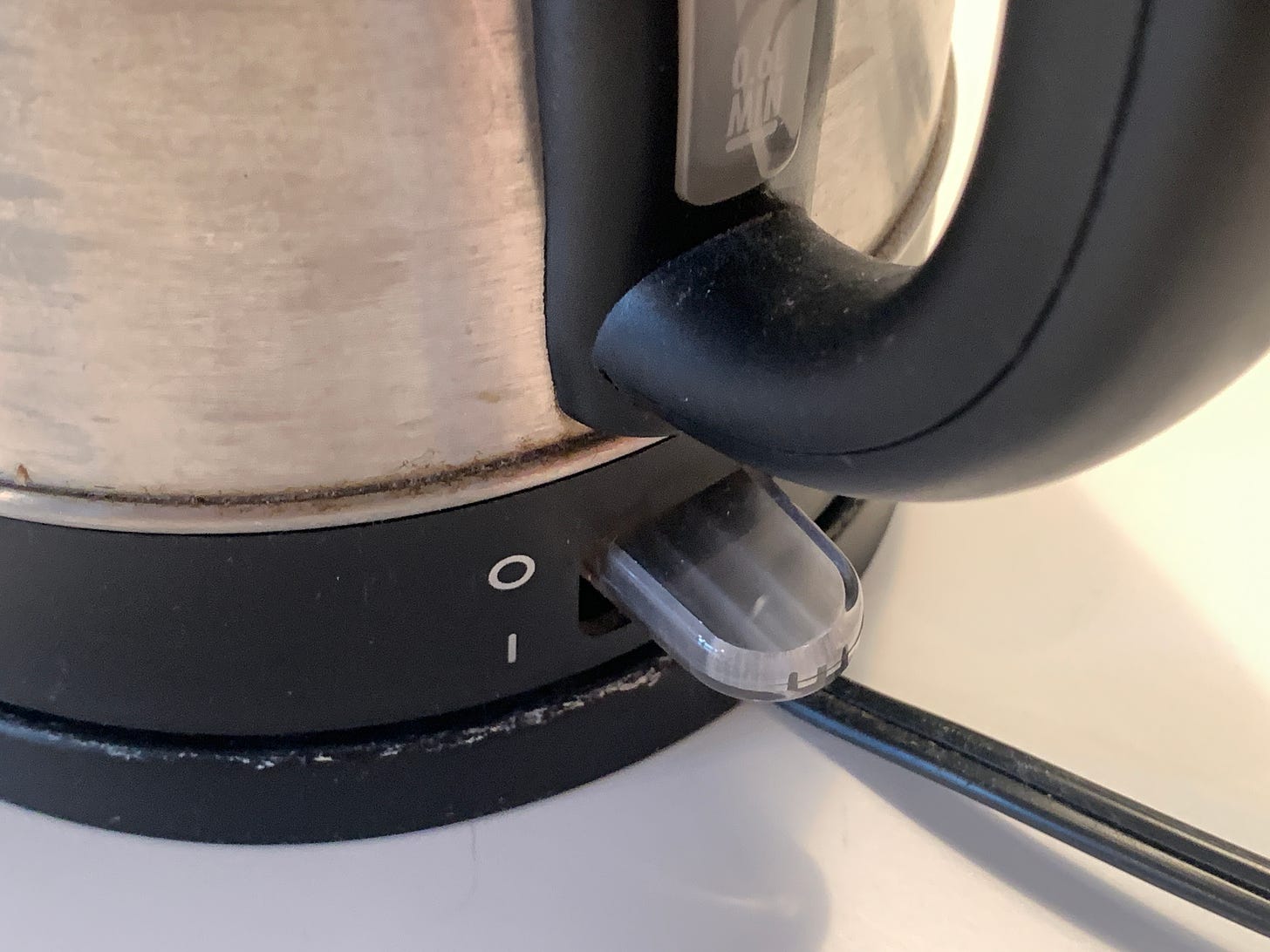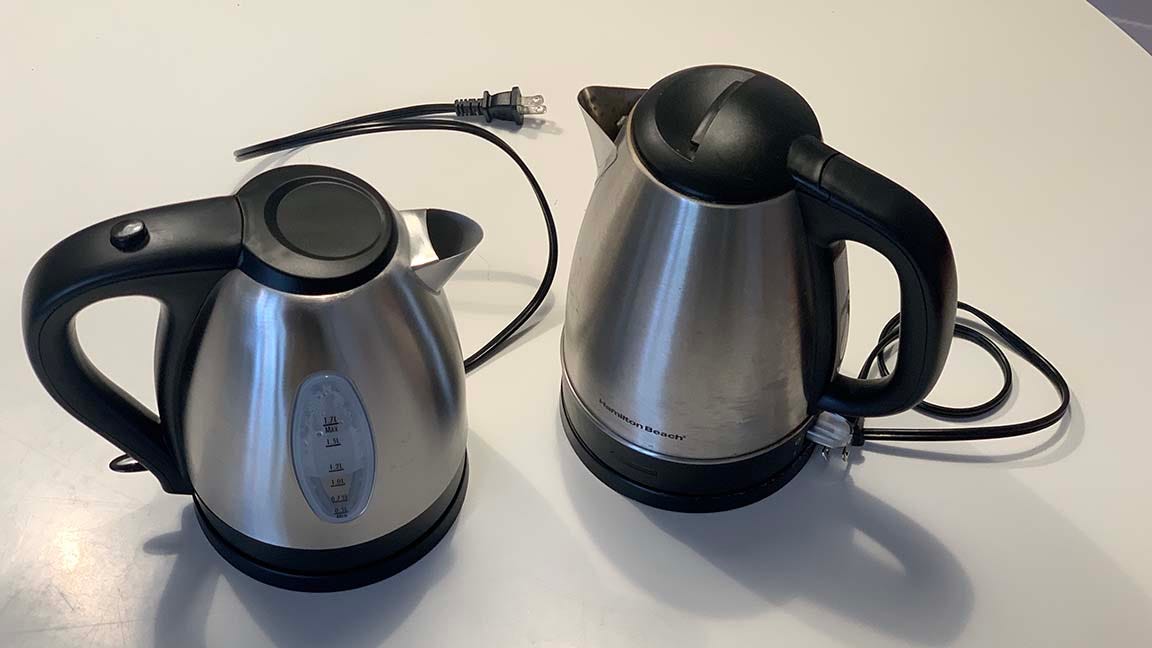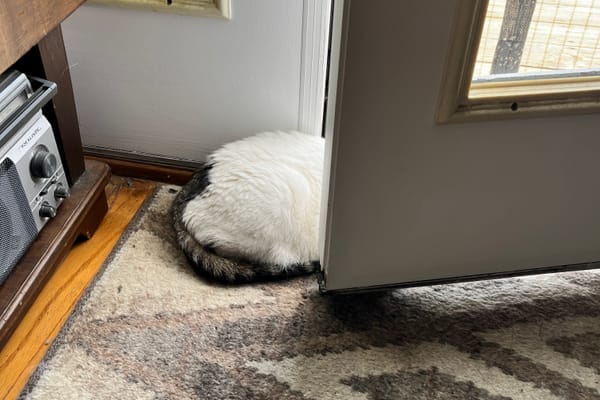DISPOSSESSIONS: A splash of cold water
INDIGNITY VOL. 4, NO. 47

DISPOSSESSIONS DEP'T.
Dispossessions: Hamilton Beach 1.7 Liter Electric Kettle
THE ELECTRIC KETTLE wasn't heating up. It took a little while to understand this, for it really to sink in, because the electric kettle worked without having to be thought about (this was one of the two great virtues of the electric kettle), and until people had drunk their morning tea, the thinking was difficult to do. Someone would dump out the kettle and fill it with new water and press the switch, and then the real attention-demanding work would begin: making breakfast, laying out the tea mugs and putting tea bags in them, setting out the lunch thermoses to get their share of the hot water, figuring out which leftovers lunch would be and getting them started in the microwave, and then—wait, the kettle hadn't boiled and clicked itself off? The kettle was cold? The morning screeched to a halt, in confusion.
For decades, I hadn't really believed in electric kettles. It seemed to me that the virtuous and correct way to boil water was by pouring it into a stainless steel teakettle and putting the kettle over a flame on the stove. Not a kettle with a whistle, either. Noticing that the kettle was boiling was the lowest possible expression of responsibility around the kitchen. The flames roared; the stainless shine vanished under baked-on blackened matter from being on the stovetop all the time; eventually, slowly, the water would come to a boil. Who needed an appliance to do something so simple?
Then our younger son was born, and rather than buying a bottle warmer, we got an electric kettle. With it, we could heat the water quickly in the dark, pour it into a mug, dunk a screwtop shot of formula into the mug, and feed the baby without putting in contact lenses or really even waking up all the way. Sometime after he'd grown out of urgent bottle-feedings, the electric kettle stopped working. No big deal. We went back to the stovetop method.
The second kettle was a gift. It went straight into a cabinet, because our apartment at the time had a hopelessly tiny kitchen. The counters could hold a drainboard, toaster, and rice cooker, and nothing else. The stovetop kettle was superior, anyway. Wasn't it?
But at last we moved to a bigger apartment, with measurably more kitchen counter space. Instead of putting the electric kettle back in the cabinet, we tried putting it on the counter. It was fast—very fast. (This was the other great virtue of the electric kettle.) It was simple. It was not encrusted in carbonized cooking spatter. Now it was the old-fashioned kettle that got tucked away. Getting hot water was as easy as it could be.

And then it wasn't. The kettle was plugged in, the switch was down, and—nothing. I hauled out the old stovetop kettle so we could have tea, and then I started investigating. The electric kettle, it turned out, almost still worked. If you kept your finger pushing down on the switch, into the little extra wiggle past the "on" position, there would be a soft electrical hum, and the orange indicator light would come on. If you held the finger there long enough, the kettle would boil.
The short-term fix was to fold a paper towel over on itself into a sort of cylindrical wad, bend the wad in half, and wedge it between the switch and the handle of the kettle. That would supply the necessary extra push. If I did a good enough job of shaping and placing the paper wad, when the kettle reached the boil, its automatic-off feature would flip the switch forcefully enough to eject the paper. If I didn't, it would boil along until somebody popped the paper out.
This worked, in the sense that it made the electric kettle boil water. It did not work in the sense that it restored the electric kettle to its normal state of functioning, the ease and simplicity of operation on which the whole electric-kettle enterprise depended. Now the kettle was one more thing to fuss with in the morning—one that theoretically might burn the house down if the paper wad got left in there long enough.
Still, I kept the kettle going in this awkward condition for a while. Whatever was wrong with it seemed obviously minor—something had worked the littlest bit loose, or had been bent the littlest bit out of shape, and that was keeping the heating circuit from operating. This couldn't be any sort of computerized setup; the kettle appeared to run on the same technology my parents' plug-in coffee percolator had run on in the 1970s. Surely there was some small repair or adjustment that would return it to normal.
Was I going to make that repair or adjustment, though? Myself? In a world of endless consumer waste, it felt sinful to give up on the kettle if something so minor could fix it. Couldn't I figure it out? There must be YouTube videos about how to do it, like there were YouTube videos about installing a new bottom seal for the dishwasher door.
Here I should probably note that the new bottom seal for the dishwasher door somehow got warped and kept popping out of its slot until it finally bumped into the heating element and melted. So I bought a new bottom seal and watched YouTube again.
I'm not much for household repairs. When we owned an actual house, I did get regrettably good at clamping temporary seals over the spontaneous pinhole leaks in the copper pipes. And in this apartment, I figured out how to swap out a broken toilet seat for a new one after the toilet seat in the kids' bathroom broke.
When the toilet seat in our bathroom broke, I was ready to replace it. Then the new seat on the kids' toilet broke. All of these seats had been installed new. They just kept breaking, because things break, because everything is built as cheaply and shoddily as possible. One of the sockets in the fixed-track ceiling fixture in the hallway quit working—after two years of service—and after trying to research better alternatives, I bought the identical fixture and hired a handyman to put it in. Weeks later, one of the sockets in the matching fixed-track light in the living room went dead. I changed the water filter in the fridge and the ice maker started making a groaning noise. The string that holds the slats in place on the miniblinds in the older boy's room snapped, up inside the housing at the top of the blinds. The toaster oven turns itself off when we start it, now and then.
Wouldn't fixing the kettle be a way to take a stand against this grinding onslaught of entropy? It was a thing that had straightforwardly worked. It could work once more.
Then again, realistically, a new kettle was $34. I could earn more than 34 bucks freelance editing or writing in the time it would take me to study a YouTube fix-it video, take the kettle base apart, and put it together again—assuming I was even right that it needed a mere adjustment and none of the parts were beyond repair. It was the work of seconds to go online and click to buy a new one.

The replacement one was the same, but not quite. I had never had any conscious affection for the design of the old one—it was brushed stainless, the base was black, the water went in the top—but I immediately decided the new version had been revamped for the worse. It was shorter and squatter; as with those science-education drawings of a highball glass and a lowball glass side by side, holding the same volume of liquid, I had to check the gauge markings to make myself believe that both of them were 1.7 liters. The window to check the level was bigger, unnecessarily so, in my view. And the switch, instead of being a flat little plate you pushed down, was a little stick you flipped up. That's definitely going to break, I thought.

Until it does break, though, the new electric kettle is on duty. I unplugged the old one. With a pang of regret, and a flash of resentment toward the portly new kettle, I flipped over the old base and fetched a Phillips screwdriver. This was also time I could have spent freelancing, but I had to know. How complicated was it inside there, really?
The screwdriver wouldn't catch. I moved the base into stronger light and looked. It was held together with tri-wing screws. Tamper-proof from the factory, for professionals only.

WEATHER REVIEWS

New York City, March 12, 2024
★★★★★ New twigs all around were shining silver with the sun. Pigeons lifted their wings into V's and plunged. The smell on the air was unambiguously spring. Tiny shreds of cloud evolved into new shapes against the wide blue sky, and tiny airplanes passed, with tiny contrails swiftly vanishing behind them. Details high on buildings stood out fine and exquisite; beauty had worked its way in even among the peeling paint and old bricks. The string quartet posed for photos in a crosswalk flooded with afternoon light. New green glowed where the slanting late rays hit a shrub on their way to casting the curls of an iron railing in shadow on the sidewalk. Crows flapped and glided down the block. The ice cream truck had been jangling around for days already, but now it fit.

EASY LISTENING DEP'T.

ADVICE DEP’T.

Ask The Sophist
GOT SOMETHING YOU need to justify to yourself, or to the world at large? Other columnists are here to judge you, but The Sophist is here to tell you why you’re right. Please send your questions to The Sophist, at indignity@indignity.net, and get the answers you want.

SANDWICH RECIPES DEP’T.
WE PRESENT INSTRUCTIONS in aid of the assembly of sandwiches from New Presentation of Cooking with Timed Recipes, by Auguste Gay with the collaboration of Anne Page. Published in 1924, and now in the Public Domain and available at archive.org for the delectation of all.
ANCHOVY AND APPLE SANDWICH
For each sandwich
2 slices of buttered bread
1 apple
4 anchovy filets
1 teaspoon capers
Peel and core apple, and pass through the meat grinder the apple, anchovy filets and capers. Mix well in a bowl. Spread on both slices of bread, put together and press lightly.
ANCHOVY AND SMOKED SALMON SANDWICH
For each sandwich
2 slices of buttered bread
4 filets of anchovy (in oil)
1 slice of smoked salmon
Chop the filets of anchovy with the smoked salmon. Spread on both slices of bread, put together and press lightly.
BACON AND NUT SANDWICH
For each sandwich
2 slices of buttered bread
2 slices of bacon
1 tablespoon nuts (any kind), chopped
1 tablespoon mayonnaise sauce
Fry the slices of bacon. When cold, chop fine. Mix together the nuts, bacon and mayonnaise sauce. Spread on both slices of bread, put together and press lightly.
If you decide to prepare and attempt to enjoy a sandwich inspired by this offering, be sure to send a picture to indignity@indignity.net.

MARKETING DEP'T.

The second printing of 19 FOLK TALES is now available for gift-giving and personal perusal! Huddle up in the waning weeks of winter with a cozy collection of stories, each of which is concise enough to read while you’re waiting for the heaviest part of the rain to pass.

HMM WEEKLY MINI-ZINE, Subject: GAME SHOW, Joe MacLeod’s account of his Total Experience of a Journey Into Television, expanded from the original published account found here at Hmm Daily. The special MINI ZINE features other viewpoints related to an appearance on, at, and inside the teevee game show Who Wants to Be A Millionaire, available for purchase at SHOPULA.
INDIGNITY is a general-interest publication for a discerning and self-selected audience. We appreciate and depend on your support!






